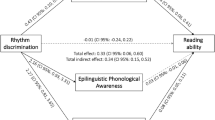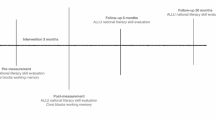Abstract
A small number of studies show that music training is associated with improvements in reading or in its component skills. A central question underlying this present research is whether musical activity can enhance the acquisition of reading skill, potentially before formal reading instruction begins. We explored two dimensions of this question: an investigation of links between kindergartners’ music rhythm skills and their phonological awareness in kindergarten and second grade; and an investigation of whether kindergartners who receive intensive musical training demonstrate more phonological skills than kindergartners who receive less. Results indicated that rhythm skill was related to phonological segmentation skill at the beginning of kindergarten, and that children who received more music training during kindergarten showed improvement in a wider range of phonological awareness skills at the end of kindergarten than children with less training. Further, kindergartners’ rhythm ability was strongly related to their phonological awareness and basic word identification skills in second grade. We argue that rhythm sensitivity is a pre-cursor skill to oral language acquisition, and that the ability to perceive and manipulate time intervals in sound streams may link performance of rhythm and phonological tasks.




Similar content being viewed by others
Notes
Lower median score indicates better performance in Tempo Copying.
Higher median score indicates better performance in Rhythm Discrimination.
Negative value of r does not imply a negative correlation.
References
Adams, M. (1990). Beginning to read: Thinking and learning about print. Cambridge, MA: MIT Press.
Anvari, S. H., Trainor, L. J., Woodside, J., & Levy, B. A. (2002). Relations among musical skills, phonological processing, and early reading ability in preschool children. Journal of Experimental Child Psychology, 83, 111–130.
Baruch, C., & Drake, C. (1997). Tempo discrimination in infants. Infant Behaviorial Development, 20, 573–577.
Beethoven, J., Brumfield, S., Campbell, P. S., Connors, D. N., Duke, R. A., & Jellison, J. A. (2005). Silver-Burdett making music: Kindergarten teacher edition. Upper Saddle River, NJ: Pearson Education.
Bradley, L., & Bryant, P. (1978). Difficulties in auditory organization as a possible cause of reading backwardness. Nature, 301, 419–421.
Brady, S. (1986). Short-term memory, phonological processing, and reading ability. Annals of Dyslexia, 36, 138–153.
Bryant, P. E., Bradley, L., Maclean, M., & Crossland, J. (1989). Nursery rhymes, phonological skills and reading. Journal of Child Language, 16, 407–428.
Butzlaff, R. (2000). Can music be used to teach reading? Journal of Aesthetic Education, 34(3/4), 167–178.
Chang, H., & Trehub, S. E. (1977). Infants’ perception of temporal grouping in auditory patterns. Child Development, 48, 1666–1670.
Cohen, J. (1990). Things I have learned (so far). American Psychologist, 45, 1304–1312.
Costa-Giomi, E. (1997). The McGill piano projects: Effects of piano instruction on children’s cognitive abilities. In Proceedings of the third triennial European Society for the Cognitive Science of Music Conference, Uppsala, Sweden.
Costa-Giomi, E. (2004). Effects of three years of piano instruction on children’s academic achievement, school performance, and self-esteem. Psychology of Music, 32, 139–152.
Curtin, S., Mintz, T. H., & Christiansen, M. H. (2005). Stress changes the representational landscape: Evidence from word segmentation. Cognition, 96, 233–262.
Cutler, A. (1991). Linguistic rhythm and speech segmentation. In L. Sundeberg, L. Nord, & R. Carlson (Eds.), Music, language, speech, and brain (Wenner-Gren symposium series 59) (pp. 157–166). London: Macmillan.
Cutler, A., & Norris, D. (1988). The role of strong syllables in segmentation for lexical access. Journal of Experimental Psychology: Human Perception and Performance, 14, 113–121.
Cutler, A., & Otake, T. (1994). Mora or phonemes? Further evidence for language-specific listening. Journal of Memory and Language, 33, 824–844.
Dana Foundation. (2008). Learning, arts, and the brain: The Dana Consortium report on arts and cognition. New York, NY: Author.
David, D., Wade-Woolley, L., Kirby, J. R., & Smithrim, K. (2007). Rhythm and reading development in school-age children: A longitudinal study. Journal of Research in Reading, 30, 169–183.
Degé, F., & Schwarzer, G. (2011). The effect of a music program on phonological awareness in preschoolers. Frontiers in Psychology, 2, 124. doi:10.3389/fpsyg.2011.00124.
Demany, L., McKenzie, B., & Vurpillot, E. (1977). Rhythm perception in early infancy. Nature, 266, 718–719.
Diamantes, T., Young, K. M., & McBee, K. (2002). An analysis of reading and content area skills improvement through music instruction. Reading Improvement, 39(3), 114–118.
Douglas, S., & Willats, P. (1994). The relationship between musical ability and literacy skills. Journal of Research in Reading, 17, 99–107.
Dunn, L. M., & Dunn, L. M. (1997). Peabody picture vocabulary test (3rd ed.). Circle Pines, MN: American Guidance Service.
Elkind, D. (2010). The hurried child: Growing up too fast too soon. Cambridge, MA: De Capo Press/Perseus Books.
Field, A. (2005). Discovering statistics using SPSS. London, UK: SAGE Publications.
Fisher, D. (2001). Early language learning with and without music. Reading Horizons, 42(1), 40–49.
Fisher, D., & McDonald, N. (2001). The intersection between music and early literacy instruction: Listening to literacy. Reading Improvement, 38, 106–115.
Fletcher, J. M., Shaywitz, S. E., Shankweiler, D. P., Katz, L., Liberman, I. Y., Stuebing, K. K., et al. (1994). Cognitive profiles of reading disability: Comparisons of discrepancy and low achievement definitions. Journal of Educational Psychology, 86, 6–23.
Goswami, U. (2002). Phonology, reading development and dyslexia: A cross-linguistic perspective. Annals of Dyslexia, 52, 141–163.
Holliman, A. J., Wood, C., & Sheehy, K. (2010). The contribution of sensitivity to speech and non-speech rhythm to early reading development. Educational Psychology, 30, 247–267.
Hurwitz, I., Wolff, P. H., Bortnick, B., & Kokas, K. (1975). Non-musical effects of the Kodály music curriculum in primary grade children. Journal of Learning Disabilities, 8, 45–52.
Jordan, T., Grall, R., Deutsch, M., & Deutsch, C. (1985). Long term effects of early enrichment: A 20 year perspective on persistence and change. American Journal of Community Psychology, 13, 393–415.
Jusczyk, P. W., Cutler, A., & Redanz, N. J. (1993). Infants’ preference for the predominant stress patterns of English words. Child Development, 64, 675–687.
Jusczyk, P. W., & Thompson, E. (1978). Perception of a phonetic contrast in multisyllabic utterances by 2-month-old infants. Perception & Psychophysics, 23, 105–109.
Kaufman, A. S., & Kaufman, N. L. (1990). Kaufman brief intelligence test. Circle Pines, MN: American Guidance Service.
Kodály, Z. (1974). The selected writings of Zoltán Kodály. London: Boosey & Hawkes.
Kujala, T., Myllyviita, K., Tervaniemi, M., Alho, K., Kallio, J., & Naatanen, R. (2000). Basic auditory dysfunction in dyslexia as demonstrated by brain activity measurements. Psychophysiology, 37, 262–266.
Liberman, I. Y., & Shankweiler, D. (1979). Speech, the alphabet and teaching to read. In L. Resnick & P. Weaver (Eds.), Theory and practice of early reading (Vol. 2, pp. 109–132). Hillside, NJ: Lawrence Erlbaum.
Mehler, J., & Christophe, A. (1995). Maturation and learning of language in the first year of life. Cambridge, MA: MIT Press.
Mehler, J., Jusczyk, P., Lambertz, G., & Halsted, N. (1988). A precursor of language acquisition in young infants. Cognition, 29, 143–178.
Montague, K. J. (2002). Music and reading: Evidence for shared cognitive processes and implications for theory, diagnosis and treatment of dyslexia. Unpublished masters’ thesis, Tufts University, Medford, MA.
Moreno, S., Bialystok, E., Barac, R., Schellenberg, E. G., Cepeda, N. J., & Chau, T. (2011). Short-term music training enhances verbal intelligence and executive function. Psychological Science, 22, 1425–1433.
Moreno, S., Marques, C., Santos, A., Santos, M., Castro, S. L., & Besson, M. (2009). Musical training influences linguistic abilities in 8-year-old children: More evidence for brain plasticity. Cerebral Cortex, 19, 712–723.
Morris, R. D., Lovett, M. W., Wolf, M., Sevcik, R. A., Steinbach, K. A., Frijters, J. C., & Shapiro, M. B. (2010). Multi-component remediation for developmental reading disabilities: IQ, socioeconomic status, and race as factors in remedial outcomes. Journal of Learning Disabilities. Advance online publication doi:10.1177/0022219409355472.
National Reading Panel. (2000). National Reading Panel: Teaching children to read: An evidence-based assessment of scientific research literature on reading and its implications for reading instruction (NIH Publication No. 00-4754). Washington, DC: National Institute of Health and National Institute of Child Health and Human Development.
Nazzi, T., Bertoncini, J., & Mehler, J. (1998). Language discrimination by newborns: Toward an understanding of the role of rhythm. Journal of Experimental Psychology: Human Perception and Performance, 24, 756–766.
Overy, K. (2003). Dyslexia and music: From timing deficits to musical intervention. Annals of the New York Academy of Sciences, 999, 497–505.
Overy, K., Nicolson, R. I., Fawcett, A. J., & Clarke, E. F. (2003). Dyslexia and music: measuring musical timing skills. Dyslexia, 9, 12–36.
Patel, A. D. (2011). Why would musical training benefit the neural encoding of speech? The OPERA hypothesis. Frontiers in Psychology, 2, 142. doi:10.3389/fpsyg.2011.00142.
Patel, A. D., & Daniele, J. R. (2003). An empirical comparison of rhythm in language and music. Cognition, 87, B35–B45.
Pouthas, V. (1996). The development of the perception of time and temporal regulation of action in infants and children. In I. Deliege & S. Sloboda (Eds.), Musical beginnings: Origins and development of musical competence (pp. 115–141). New York: Oxford University Press.
Ramus, F., Nespor, M., & Mehler, J. (1999). Correlates of linguistic rhythm in the speech signal. Cognition, 73, 265–292.
Robertson, C., & Salter, W. (1997). The phonological awareness test. East Moline, IL: LinguiSystems.
Stanovich, K. (1986). Cognitive processes and the reading problems of learning disabled children: Evaluating the assumption of specificity. In J. Torgesen & B. Wong (Eds.), Psychological and educational perspectives on learning disabilities (pp. 87–131). New York, NY: Academic Press.
Szönyi, E. (1973). Kodály’s principles in practice: An approach to music education through the Kodály method. London, UK: Boosey & Hawkes.
Torgesen, J. K., Alexander, A. W., Wagner, R. K., Rashotte, C. A., Voeller, K., & Conway, T. (2001). Intensive remedial instruction for children with severe reading disabilities: Immediate and long-term outcomes from two instructional approaches. Journal of Learning Disabilities, 34, 33–58.
Torgesen, J., Wagner, R., & Rashotte, C. (1999). Test of word reading efficiency (TOWRE). Bloomington, MN: Pearson Assessments.
Trehub, S. E., & Thorpe, L. A. (1989). Infants’ perception of rhythm: categorization of auditory sequences by temporary structure. Canadian Journal of Psychology, 43, 217–229.
Wagner, R., & Torgesen, J. (1987). The nature of phonological processing and its causal role in the acquisition of reading skills. Psychological Bulletin, 101, 192–212.
Wagner, R., Torgesen, J., & Rashotte, C. (1999). Comprehensive test of phonological processing (CTOPP). Bloomington, MN: Pearson Assessments.
Witton, C., Talcott, J. B., Hansen, P. C., Richardson, A. J., Griffiths, T. D., Rees, A., et al. (1998). Sensitivity to dynamic auditory and visual stimuli predicts nonword reading ability in both dyslexics and normal readers. Current Biology, 8, 791–797.
Wolf, M. (2007). Proust and the squid: The story and science of the reading brain. New York, NY: HarperCollins.
Wolf, M., Miller, L., & Donnelly, K. (2000). Retrieval, automaticity, vocabulary, elaboration, orthography (RAVE-O): A comprehensive, fluency-based reading intervention program. Journal of Learning Disabilities, 33, 375–386.
Wolff, P. (2002). Timing precision and rhythm in developmental dyslexia. Reading and Writing: An Interdisciplinary Journal, 15, 179–206.
Wood, C., Wade-Woolley, L., & Holliman, A. J. (2009). Phonological awareness: Beyond phonemes. In C. Wood & V. Connelly (Eds.), Contemporary perspectives on reading and spelling (pp. 7–23). New York, NY: Routledge.
Woodcock, R. W. (1998). Woodcock reading mastery tests-revised (WRMT-R). Circle Pines, MN: American Guidance Service.
Acknowledgments
We express our deep gratitude to the school administrators, teachers, parents, and children who participated. The second author was partially supported by the APA/Institute of Education Sciences Postdoctoral Education Research Training (IES-PERT) fellowship. During the preparation of this article, the third author was partially supported by the European project COST ISCH Action TD0904 Time In MEntaL activitY: theoretical, behavioral, bioimaging and clinical perspectives (TIMELY).
Author information
Authors and Affiliations
Corresponding author
Rights and permissions
About this article
Cite this article
Moritz, C., Yampolsky, S., Papadelis, G. et al. Links between early rhythm skills, musical training, and phonological awareness. Read Writ 26, 739–769 (2013). https://doi.org/10.1007/s11145-012-9389-0
Published:
Issue Date:
DOI: https://doi.org/10.1007/s11145-012-9389-0




